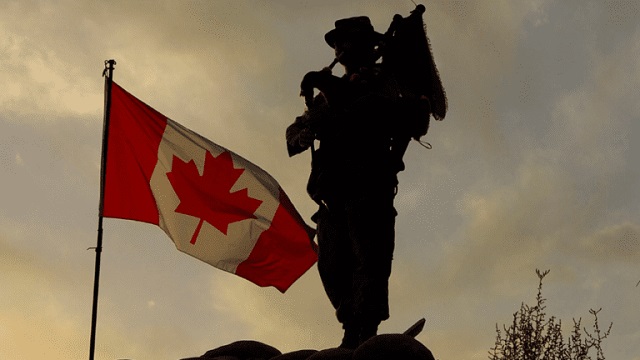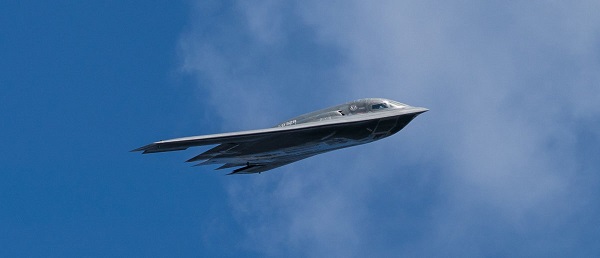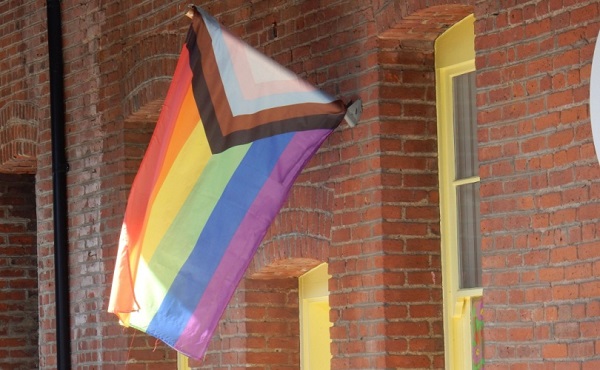armed forces
We can do more than just remember. Let’s actually support those who serve.

From the MacDonald Laurier Institute
By Richard Shimooka
Many veterans transition to civilian life feeling rudderless and alone and missing necessary support structures
Remembrance Day is the one time in the year that the lives and issues facing soldiers and veterans intrude into the public consciousness in any substantial way. Yet the image that is evoked is heavily based on the Second World War and Korean War experiences—conflicts that have directly affected a dwindling generation of individuals. Meanwhile, the lives and challenges of our current generation of soldiers and veterans are very different and not well understood.
The reality can be grim. A 2014 Statistics Canada Study showed that 48 percent of Canadian Armed Forces (CAF) members will experience a major mental health condition or alcoholic abuse in their lifetime. While currently serving personnel do not see an increase in suicide rates relative to the population, the suicide rate for male veterans after their release is 50 percent higher than the general population, 200 percent higher for female veterans, and 250 percent higher for male veterans under the age of 25.
These sorts of statistics, backed up by anecdotal evidence, cast a dour light on their overall military experience. I think the problem can be distilled down to a series of lies that exist at the heart of Canada’s relationship with its military members.
The government asks members of the Canadian Armed Forces for unlimited liability, and in return, CAF members trust the government to provide them with the tools to do their jobs and the policies and systems to take care of them in their most vulnerable times. This social contract is at the core of military service—and the government is essentially lying when it claims that it is upholding its side of the agreement. And due to that failure, soldiers often suffer a lifetime moral injury as a result.
First, it is fairly evident that military personnel are not being provided the resources required to carry out their jobs properly. In procurement, for example, considerations such as “social license” and “industrial and technical benefits” edge out the needs of soldiers, often leaving them with inadequate capabilities to achieve their missions. It often leaves soldiers across the CAF feeling disrespected despite their ongoing sacrifices,
But this is only one part of the issue. The CAF and Veterans Affairs Canada’s (VAC) personnel policies towards current and former military members are simply inadequate. It takes a certain type of person to join the CAF and remain in service for any length of time. In most cases, those very skills, knowledge, and work habits that are in demand within the CAF today are also highly sought after in the Canadian workforce—and often at significantly higher pay scales than what is offered within the military. CAF members are often shuttled to remote bases in places like Cold Lake, Shilo, or Oromucto, then sent on months-long deployments abroad. The continued outsourcing of key military benefits, such as housing and movement grants, and the inability to have a credible grievance mechanism, have produced a military experience that varies wildly from soldier to soldier in an already complex and stressful job.
Furthermore, spouses and families often bear the brunt of the challenging military lifestyle. Many of Canada’s bases are located far from major metropoles. Remember, with the CAF requiring more highly trained soldiers, it is likely that their spouses also have similar educational and employment skill sets—ones that cannot be met in remote military towns. While official statistics are scarce, there is some evidence suggesting that divorce rates for current and former military members are significantly higher than in the general population.
Most destructive is just how inept the government’s personnel management policies are. First, systems for overseeing current members and veterans employ antiquated data management systems, which creates barriers to accessing services.
This brings us to a broader point: the relationship between the bureaucracy and soldiers and veterans is not a harmonious one. At best it can be described as adversarial. At every step, current and former military members have to prove their eligibility for programs to skeptical public servants and/or contractors. They must become records packrats as they never know when a key piece of information will become critical to proving the validity of their claim.
The focus of the “system” seems like it is less there to assist individuals in need and more there to prevent the almost minuscule possibility that fraud may occur. This lack of trust manifests itself in so many different ways, altering health benefits for dependents, even for the widows/widowers of soldiers and veterans, cost of living rebates, and more.
Furthermore, even the programs and policy alternatives that are available are deliberately left unpublicized, perhaps in a misguided effort to keep departmental costs down. It is often through word of mouth or online communities that the existence of these policies (and how to access them) is disseminated amongst veterans or serving members. This illustrates the reality of the situation and the lie that the government is doing its best to help current and former military members. Rather, it actively works against them in some important instances.
Despite all of this, it can be surprising that so many members choose to remain in service to their country. Certainly, the higher calling that comes with public service is an important motivator: they strive hard to uphold their side of the social contract.
Another issue, though, is that there is also a “big lie” that current soldiers and veterans tell themselves to make it through: that everything is alright.
I can’t tell you how many allied personnel will rave about the relentless resourcefulness of Canadian military personnel. This is colloquially referred to as the “can-do” attitude. A culture of essentially getting things done regardless of the risk.
But there is more to it than that. Certainly, there was an element of masculinity that has inhibited soldiers from seeking help. Furthermore, the fears exist among personnel that acknowledging mental defects could impact their future service progression. The failure to repeal or mitigate Paragraph 98 (c) of the National Defence Act, which criminalizes self-harm, is one of several policies that stigmatizes those who suffer mental health episodes.
At its root, the broader CAF culture explains some of the relationship dynamics between superiors and subordinates. If soldiers are conditioned to not express how they feel, it makes it difficult for them to then turn around and be effective at dealing with the issues within their organization. We can laud the perceptive leaders who intrinsically understand the corrosive effect these issues have on their subordinates’ lives and try to rectify them, but it is a challenge for many in command positions because they have been conditioned within this culture to avoid these questions.
Moreover, there’s the pervasive reality that the CAF requires a unique culture to undertake its primary task of providing for the security and defence of Canada and its interests. As I mentioned in a previous column, the CAF’s culture is the glue that holds the force together in extremely difficult operations. Yet that focus on conformity can also result in destructive effects on some members’ psyche.
Given all of these considerations, it is not at all surprising that soldiers essentially lie to themselves about their situation in order to get through each day. Fortunately, they have a clear sense of purpose while serving their country; often, however, veterans do not. Many transition to civilian life feeling rudderless and alone, without the support structures that allowed them to operate at high levels while in the service. Even worse, some veterans are deliberately made to feel the burden of a system that was created to treat service-related injuries.
In the end, usurping these lies is not insurmountable, but it will require dedicated time, effort, and resources to overcome them. In short, robust political support across all parties has been lacking for many decades. Overhauling the relationship will have practical benefits that will go far beyond just meeting the needs of soldiers and their families. It will go a long way in addressing the retention and potentially the recruitment crisis that has deeply affected the CAF for the past decade.
But aside from that, it is just the morally right thing to do, and that really should be the guiding position for any policy in this area. Beyond just taking the time to remember their sacrifices for one day once a year, providing tangible improvements to the lives and working conditions of soldiers and veterans would be a meaningful way to thank them for their service.
Richard Shimooka is a Hub contributing writer and a senior fellow at the Macdonald-Laurier Institute who writes on defence policy.
armed forces
Ottawa’s Newly Released Defence Plan Crosses a Dangerous Line

From the Frontier Centre for Public Policy
By David Redman
Canada’s Defence Mobilization Plan blurs legal lines, endangers untrained civil servants, and bypasses provinces. The Plan raises serious questions about military overreach, readiness, and political motives behind rushed federal emergency planning.
The new defence plan looks simple on paper. The risks are anything but.
Canadians have grown used to bad news about the Canadian Armed Forces (CAF), but the newly revealed defence mobilization plan is in a category of its own.
After years of controversy over capability, morale, and leadership challenges, the military’s senior ranks now appear willing to back a plan that misunderstands emergency law, sidelines provincial authority, and proposes to place untrained civil servants in harm’s way.
The document is a Defence Mobilization Plan (DMP), normally an internal framework outlining how the military would expand or organize its forces in a major crisis.
The nine-page plan was dated May 30, 2025, but only reached public view when media outlets reported on it. One article reports that the plan would create a supplementary force made up of volunteer public servants from federal and provincial governments. Those who join this civil defence corps would face less restrictive age limits, lower fitness requirements, and only five days of training per year. In that time, volunteers would be expected to learn skills such as shooting, tactical movement, communicating, driving a truck, and flying a drone. They would receive medical coverage during training but not pensionable benefits.
The DMP was circulated to 20 senior commanders and admirals, including leaders at NORAD, NATO, special forces, and Cybercom. The lack of recorded objection can reasonably raise concerns about how thoroughly its implications were reviewed.
The legal context explains much of the reaction. The Emergencies Act places responsibility for public welfare and public order emergencies on the provinces and territories unless they request federal help. Emergency response is primarily a provincial role because provinces oversee policing, natural disaster management, and most front-line public services. Yet the DMP document seems to assume federal and military control in situations where the law does not allow it. That is a clear break from how the military is expected to operate.
The Emergency Management Act reinforces that civilian agencies lead domestic emergencies and the military is a force of last resort. Under the law, this means the CAF is deployed only after provincial and local systems have been exhausted or cannot respond. The Defence Mobilization Plan, however, presents the military as a routine responder, which does not match the legal structure that sets out federal and provincial roles.
Premiers have often turned to the military first during floods and fires, but those political habits do not remove the responsibility of senior military leaders to work within the law and respect their mandate.
Capacity is another issue. Combat-capable personnel take years to train, and the institution is already well below its authorized strength. Any task that diverts resources from readiness weakens national defence, yet the DMP proposes to assign the military new responsibilities and add a civilian component to meet them.
The suggestion that the military and its proposed civilian force should routinely respond to climate-related events is hard to square with the CAF’s defined role. It raises the question of whether this reflects policy misjudgment or an effort to apply military tools to problems that are normally handled by civilian systems.
The plan also treats hazards unrelated to warfighting as if the military is responsible for them. Every province and territory already has an emergency management organization that monitors hazards, coordinates responses and manages recovery. These systems use federal support when required, but the military becomes involved only when they are overwhelmed. If Canada wants to revive a 1950s-style civil defence model, major legislative changes would be needed. The document proceeds as if no such changes are required.
The DMP’s training assumptions deepen the concerns. Suggesting that tasks such as “shooting, moving, communicating, driving a truck and flying a drone” can be taught in a single five-day block does not reflect the standards of any modern military. These skills take time to learn and years to master.
The plan also appears aligned with the government’s desire to show quick progress toward NATO’s defence spending benchmark of two percent of GDP and eventually five percent. Its structure could allow civil servants’ pay and allowances to be counted toward defence spending.
Any civil servant who joins this proposed force would be placed in potentially hazardous situations with minimal training. For many Canadians, that level of risk will seem unreasonable.
The fact that the DMP circulated through senior military leadership without signs of resistance raises concerns about accountability at the highest levels. That the chief of the defence staff reconsidered the plan only after public criticism reinforces those concerns.
The Defence Mobilization Plan risks placing civil servants in danger through a structure that appears poorly conceived and operationally weak. The consequences for public trust and institutional credibility are becoming difficult to ignore.
David Redman had a distinguished military career before becoming the head of the Alberta Emergency Management Agency in 2004. He led the team in developing the 2005 Provincial Pandemic Influenza Plan. He retired in 2013. He writes here for the Frontier Centre for Public Policy.
armed forces
Global Military Industrial Complex Has Never Had It So Good, New Report Finds


From the Daily Caller News Foundation
The global war business scored record revenues in 2024 amid multiple protracted proxy conflicts across the world, according to a new industry analysis released on Monday.
The top 100 arms manufacturers in the world raked in $679 billion in revenue in 2024, up 5.9% from the year prior, according to a new Stockholm International Peace Research Institute (SIPRI) study. The figure marks the highest ever revenue for manufacturers recorded by SIPRI as the group credits major conflicts for supplying the large appetite for arms around the world.
“The rise in the total arms revenues of the Top 100 in 2024 was mostly due to overall increases in the arms revenues of companies based in Europe and the United States,” SIPRI said in their report. “There were year-on-year increases in all the geographical areas covered by the ranking apart from Asia and Oceania, which saw a slight decrease, largely as a result of a notable drop in the total arms revenues of Chinese companies.”
Notably, Chinese arms manufacturers saw a large drop in reported revenues, declining 10% from 2023 to 2024, according to SIPRI. Just off China’s shores, Japan’s arms industry saw the largest single year-over-year increase in revenue of all regions measured, jumping 40% from 2023 to 2024.
American companies dominate the top of the list, which measures individual companies’ revenue, with Lockheed Martin taking the top spot with $64,650,000,000 of arms revenue in 2024, according to the report. Raytheon Technologies, Northrop Grumman and BAE Systems follow shortly after in revenue,
The Czechoslovak Group recorded the single largest jump in year-on-year revenue from 2023 to 2024, increasing its haul by 193%, according to SIPRI. The increase is largely driven by their crucial role in supplying arms and ammunition to Ukraine.
The Pentagon contracted one of the group’s subsidiaries in August to build a new ammo plant in the U.S. to replenish artillery shell stockpiles drained by U.S. aid to Ukraine.
“In 2024 the growing demand for military equipment around the world, primarily linked to rising geopolitical tensions, accelerated the increase in total Top 100 arms revenues seen in 2023,” the report reads. “More than three quarters of companies in the Top 100 (77 companies) increased their arms revenues in 2024, with 42 reporting at least double-digit percentage growth.”
-

 Community2 days ago
Community2 days agoCharitable giving on the decline in Canada
-

 Business2 days ago
Business2 days agoCanada’s recent economic growth performance has been awful
-

 Alberta2 days ago
Alberta2 days agoCanada’s New Green Deal
-

 armed forces2 days ago
armed forces2 days agoOttawa’s Newly Released Defence Plan Crosses a Dangerous Line
-

 Health1 day ago
Health1 day agoSaskatchewan woman approved for euthanasia urged to seek medical help in Canada rather than US
-

 Alberta1 day ago
Alberta1 day agoAlberta’s huge oil sands reserves dwarf U.S. shale
-

 Business2 days ago
Business2 days agoCOP30 finally admits what resource workers already knew: prosperity and lower emissions must go hand in hand
-

 Health1 day ago
Health1 day agoCanadian gov’t considers sharing census data on gender-confused children






